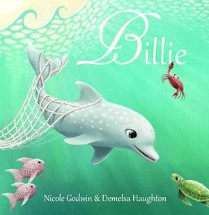Billie by Nicole Godwin and Demelsa Haughton

Tusk Books, 2018. ISBN 9780994531414
Billie the dolphin loves the wildness of surfing the ocean's waves -
for her there is no greater thrill. And so she sets off to find the
most enormous wave that she can, one that will make her happy, safe
and free. But in her search for that one wonderful wave, she
encounters more than she expected as she finds fellow marine
creatures entangled in the human detritus and pollution of the
ocean. Fishing lines, plastic bags, nets, noise . . . all are
modern-day hazards that have to be navigated as the ocean's
creatures go about their daily lives. Billie helps to free as many
as she can, but when she herself is caught in a net and her new
friends come to rescue her, she finds something that is even better
than surfing the enormous waves.
The Canberra author of Ella has made it her mission to be a voice
for those creatures of the wild who don't have their own voice to
bring attention to the destruction of their habitat. Many young
readers will be familiar with the sight of dolphins surfing the
waves and develop a fascination for these beautiful, intelligent
creatures from a young age. But they are unaware of the issues that
dolphins face as the human world encroaches more and more on their
environment and so it is books like this that carry a critical
message of conservation as well as a charming story that inspire
them to action. Rather like the little wave that forms and is then
apparently lost in the vast ocean, but in fact becomes part of a
larger wave, so the voices of authors like Godwin and illustrators
like Haughton who has created such vivid images become bigger and
bigger and louder and louder as both Ella and Billie are shared with
our young students as part of the sustainability perspective of the
Australian Curriculum.
The final double spread explains more about the issues that Billie
encountered on her journey, and part of this includes the statement,
'One of the saddest parts of my journey was not being able to help
my friends in the dolphin park. They belong in the wild, not in
tanks.' This has the potential to become a formal debate on the role
of places like SeaWorld and other venues where dolphins are held in
captivity, perhaps even extending to the roles of zoos in the
understanding and conservation of the planet's fauna. So while this
appears to be a picture book for the very young, it has scope to be
used with a much wider, older audience.
Barbara Braxton